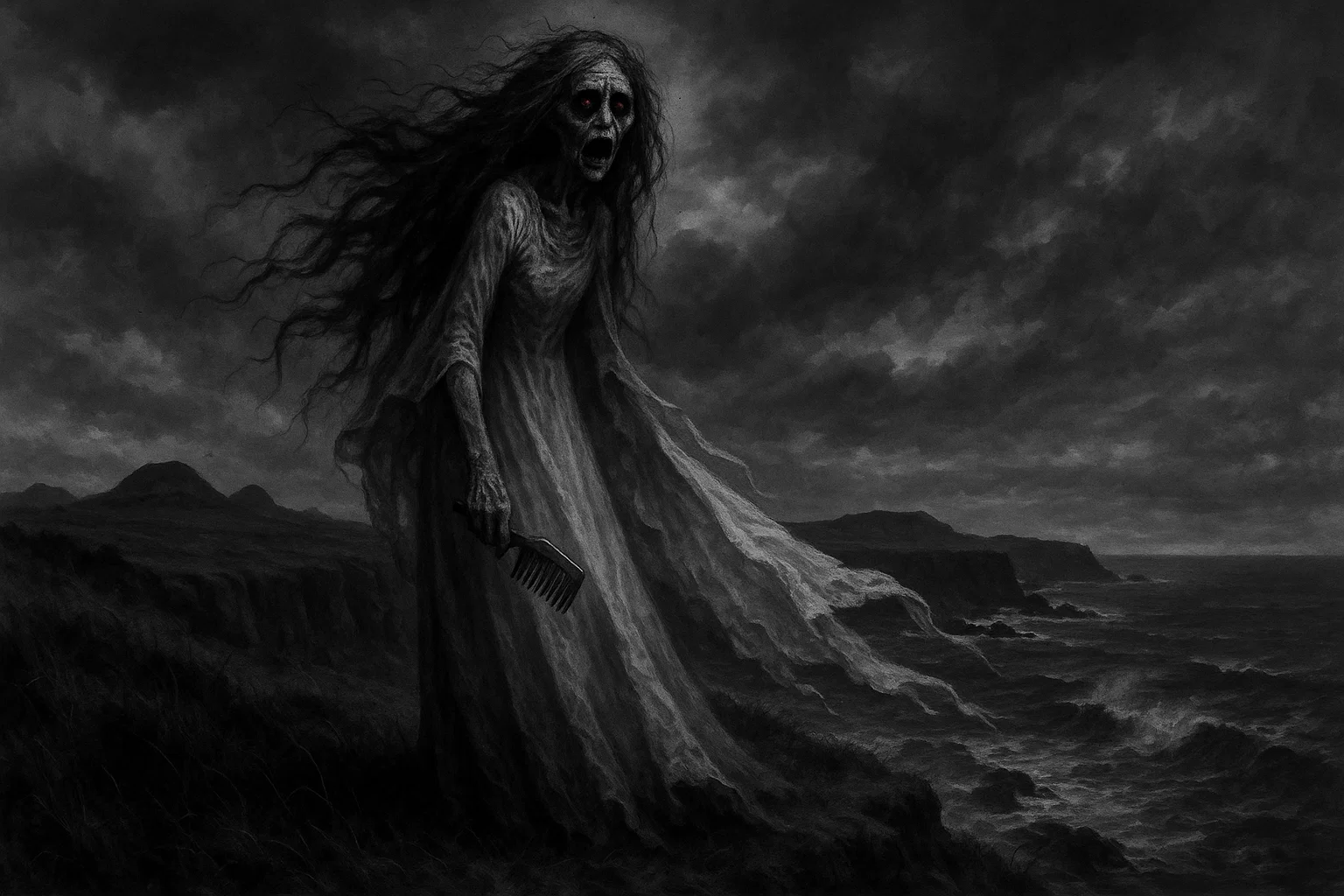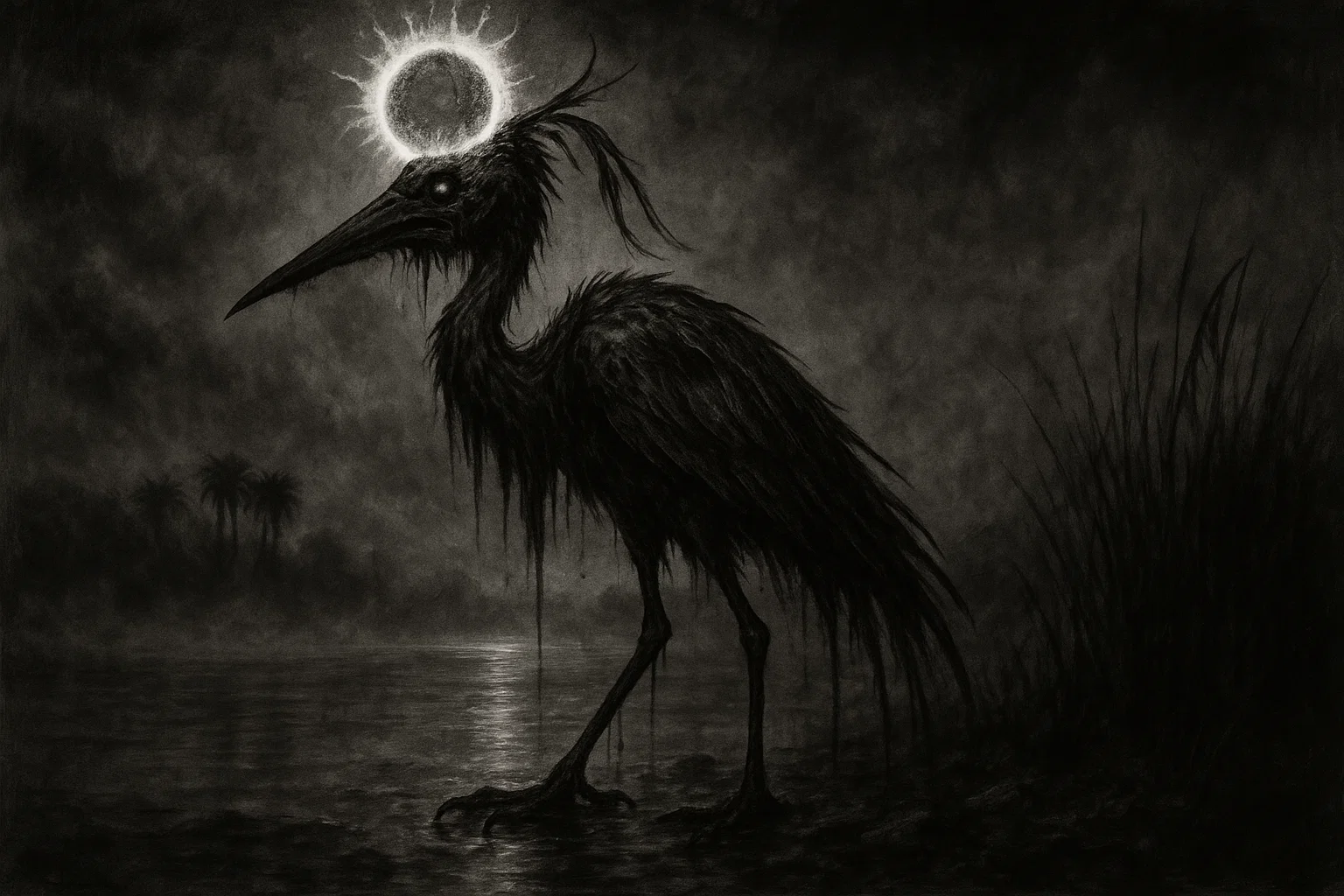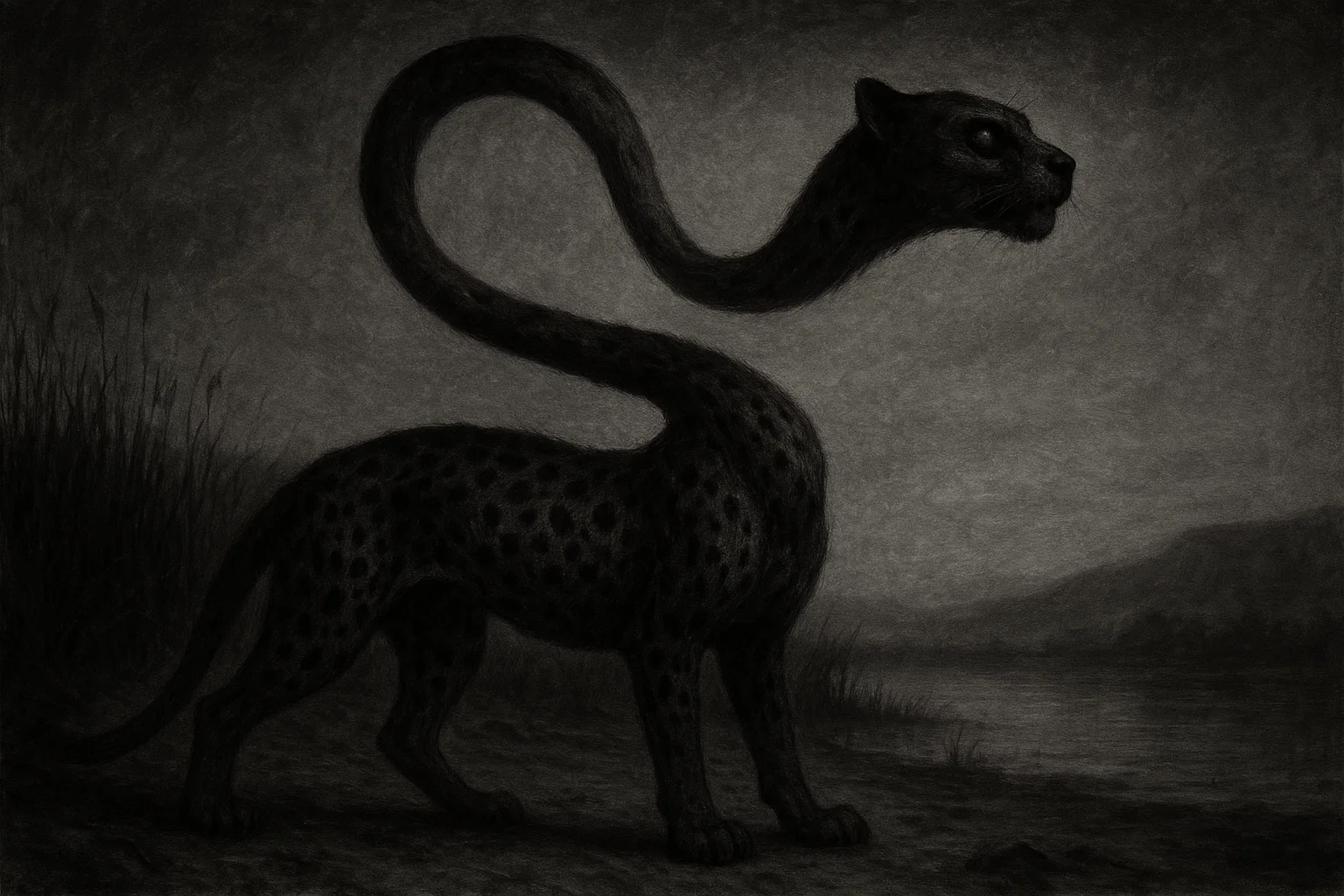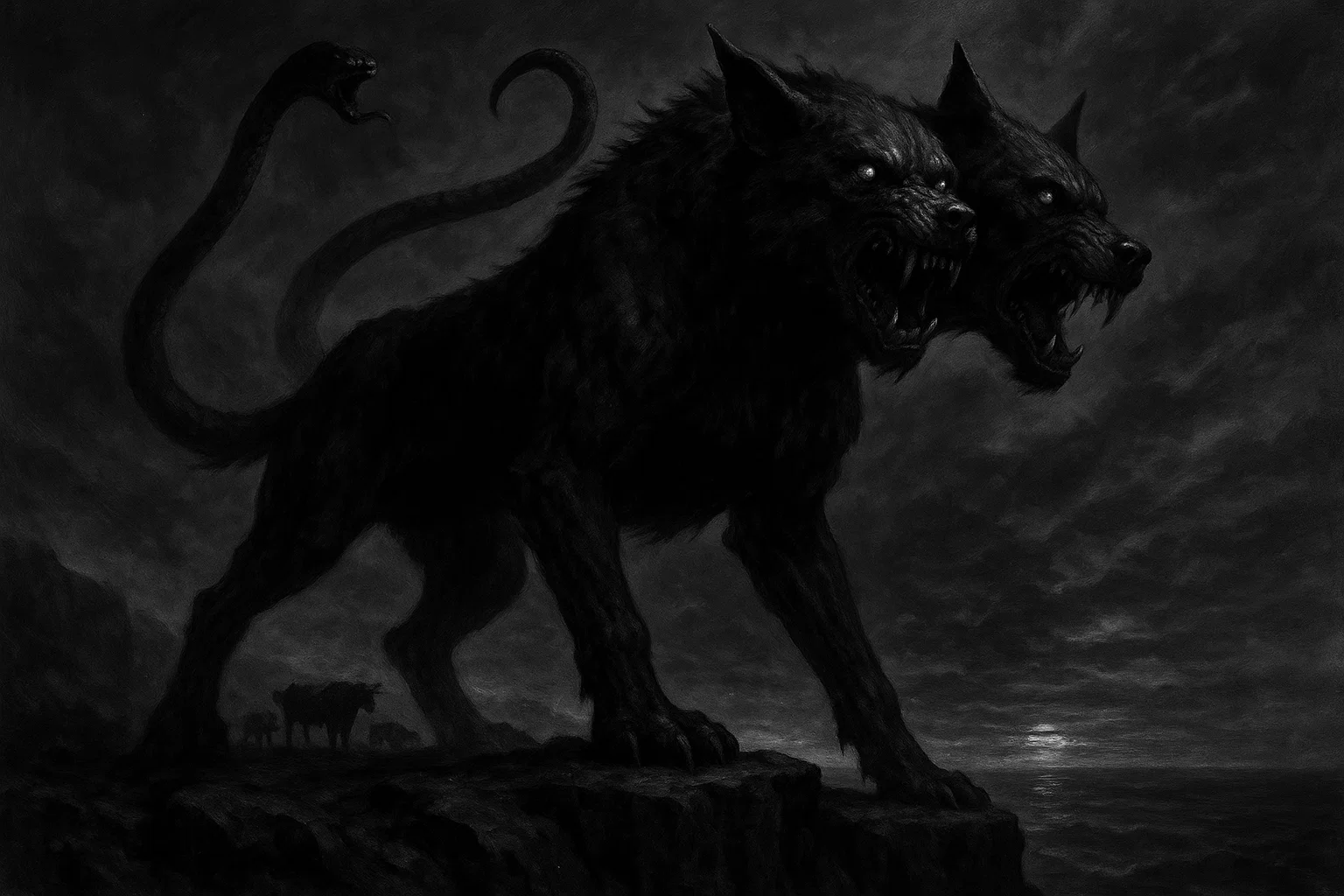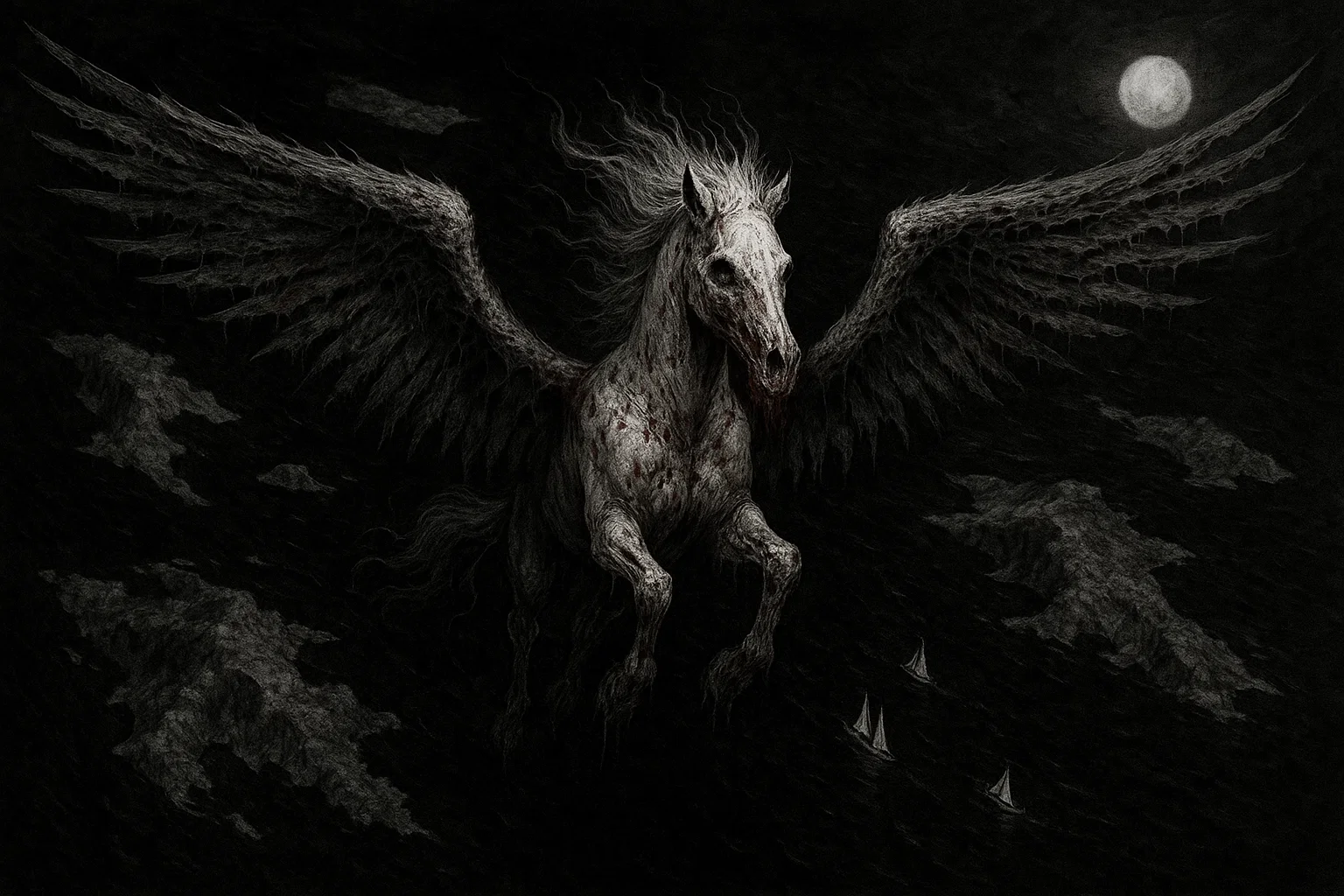The Draugr, a fearsome undead creature from Norse mythology, stalks the shadowy burial mounds of Scandinavia, embodying the terror of the restless dead.
Rooted in Viking folklore, this reanimated corpse guards treasures and torments the living with its malevolent spirit.
Summary
Overview
| Trait | Details |
|---|---|
| Names | Draugr, draug, draugar, draugur, dreygur, draugen; Old Norse “revenant.” |
| Nature | Undead revenant; animated corpse driven by vengeful or greedy spirits. |
| Species | Humanoid; reanimated human corpse with supernatural powers. |
| Appearance | Blue-black (hel-blár), bloated, decaying; emits stench, glowing grave. |
| Area | Iceland, Norway, Denmark; burial mounds in Vestfold, Uppland, Reykjavík. |
| Behavior | Malevolent; attacks living, guards treasure, spreads disease, curses foes. |
| Creation | Improper burial, violent death, curse, or infection by another Draugr. |
| Weaknesses | Decapitation, burning, ashes scattered at sea; iron wounds, rituals banish. |
| First Known | Laxdæla saga (circa 1245), Iceland; mentions undead in burial mounds. |
| Myth Origin | Pre-Christian Norse beliefs; Viking fears of afterlife, ancestor worship. |
| Strengths | Superhuman strength, shape-shifting (seals, cats), weather control, visions. |
| Habitat | Burial mounds, barrows, tombs; coastal regions like Skagafjörður, Iceland. |
| Diet | Human flesh, blood, souls; feeds on fear, misery of victims. |
| Protection | Iron nails in graves, rowan wood, runestones, proper burial rites. |
| Time Active | Nocturnal; most active during Jól (Yule, December) or dark winter nights. |
What Is a Draugr?
The Draugr is a malevolent undead entity in Norse mythology, a reanimated corpse haunting burial mounds and barrows. Unlike spectral ghosts, Draugar possess physical bodies, retaining traits like strength, cunning, or even magical abilities from their former lives.
Known for guarding treasures buried with them, they attack the living out of envy, greed, or vengeance, often spreading disease or curses, making them a terrifying symbol of death’s unrest in Viking culture.
Etymology
The term Draugr originates from Old Norse, meaning “revenant” or “undead man,” encapsulating the creature’s identity as a reanimated corpse in Norse mythology.
Derived from the Proto-Germanic root draugaz, meaning “delusion,” “illusion,” or “phantom,” the word suggests a deceptive, liminal being that blurs the line between life and death.
This etymological root connects to the Draugr’s ability to shape-shift and deceive, as seen in sagas where they appear as animals or humans to lure victims.
The term Draugr (pronounced /ˈdrɔɪɡər/ in Old Norse, with a diphthong akin to “droy-gr”) appears in several medieval Icelandic texts, with the earliest recorded use in Laxdæla saga (circa 1245), which describes a restless corpse haunting a burial mound in Iceland’s Breiðafjörður region.
Variations include draugur in modern Icelandic, pronounced /ˈtrœyːɣʏr/, reflecting a softer, more guttural sound, and dreygur in Faroese, used in 13th-century oral tales of undead sailors.
In Danish, Swedish, and Norwegian, the form draug (pronounced /drɑːʊɡ/) often refers to sea-ghosts, a shift seen in 16th-century Danish folklore from Zealand, where draugen haunt coastal waters rather than graves.
Related terms in other Germanic languages deepen the Draugr’s linguistic context. The Old English dréag (“phantom” or “ghost”) appears in the 10th-century Beowulf manuscript, describing spectral figures akin to Draugar, suggesting a shared Germanic fear of restless spirits.
The Middle High German trūc (“deceiver”) also ties to draugaz, emphasizing the creature’s trickery, as in Hrómundar saga Gripssonar (circa 1300), where Þráinn shape-shifts into a seal. These connections highlight the Draugr’s role across Germanic mythologies as a malevolent, deceptive undead.
Regional variations reflect cultural nuances. In Norway’s Vestfold, 12th-century skalds used draug to describe mound-dwellers, as recorded in Ynglinga saga (circa 1225) by Snorri Sturluson, linking the term to royal burial mounds like those at Gamla Uppsala.
In Iceland, draugar (plural) appears in Eyrbyggja saga (circa 1260), emphasizing multiple undead in Snæfellsnes, tied to communal fears of improper burials. The Faroese dreygur, documented in 14th-century ballads, often describes undead tied to shipwrecks, blending Norse and maritime folklore.
The term’s evolution also reflects Christian influences. By the 13th century, as Christianity spread across Scandinavia, Draugr began to carry connotations of damnation, seen in Njáls saga (circa 1280), where undead figures symbolize divine punishment for unrepented sins.
This shift aligns with the Old Norse draumr (“dream” or “vision”), suggesting Draugar as nightmarish apparitions, a motif in Grettis saga (circa 1310–1320), where Glámr’s glowing eyes haunt Grettir’s dreams.
Connections to related myths extend beyond Norse culture. The Proto-Indo-European root dʰrewgʰ- (“to deceive”) links Draugr to Slavic upiór (“vampire”) and Irish draug (“specter”), both tied to restless dead in early medieval tales.
In 11th-century Anglo-Saxon chronicles, dréag parallels Draugr stories, describing undead warriors in barrows, suggesting a shared fear of the grave across northern Europe.
These linguistic ties underscore the Draugr’s place in a broader tapestry of undead mythology, rooted in ancient fears of death’s incomplete passage.
You May Also Like: Murmur, Duke of Hell: The Demon Who Commands the Dead
What Does a Draugr Look Like?
The Draugr’s appearance is grotesque and varied, often described as hel-blár (death-blue) or nár-fölr (corpse-pale), with skin ranging from blackened to bluish-gray, as seen in Grettis saga’s Glámr, whose body is “blue as hell and bloated like a bull.”
Their flesh may appear leathery, shriveled, or swollen, exuding a putrid stench of decay.
In Eyrbyggja saga, Þórólfr Lame-foot is uncorrupted yet “black as death,” with matted hair and claw-like nails. Some Draugar, like Þráinn in Hrómundar saga, have jagged teeth and eyes that gleam with an eerie, foxfire-like glow, especially near graves.
Regional tales from Iceland’s Skagafjörður describe Draugar with tattered burial shrouds or seaweed-covered limbs, reflecting coastal influences.
Mythology
The Draugr’s origins trace back to Scandinavia’s pagan era, before the Christianization of the region in the 9th and 10th centuries, when ancestor worship and elaborate burial rituals shaped spiritual practices.
Unlike later European undead, such as the vourdalak tied to the 1732 Serbian vampire panic, the Draugr is distinctly Norse, emerging from a worldview where the dead could influence the living, either as protectors or malevolent forces.
Pre-Literary Beliefs and Viking Afterlife
In pre-Christian Norse society, death was a transition rather than an end, with the dead believed to linger near their burial sites.
Archaeological evidence, like the Oseberg ship burial (834 CE) in Vestfold, Norway, shows meticulous burial practices, including grave goods like gold, weapons, and boats, meant to appease the deceased.
The Draugr arose when these rituals failed—due to violent deaths, unavenged grievances, or greed for earthly treasures. Oral traditions from 8th-century Denmark and Sweden, preserved in skaldic poetry, describe haugbui (mound-dwellers), early precursors to Draugar, who guarded their barrows against intruders.
These beliefs likely stemmed from a fear of ancestral wrath, where the dead could curse the living, as seen in runestone inscriptions like the Rök Stone (circa 800 CE), which warns of supernatural consequences for disturbing graves.
Plagues, Wars, and Social Unrest
The Draugr’s myth was shaped by historical events that amplified fears of death and the supernatural.
During the late 8th century, Viking raids, such as the 793 CE attack on Lindisfarne, heightened concerns about violent deaths, as warriors often died far from home without proper burials.
The Viking Age (793–1066 CE) saw frequent conflicts, like the Battle of Hafrsfjord (circa 872 CE), which left many unburied corpses, fueling tales of restless dead. Epidemics, though less documented in Scandinavia than in later European vampire panics, also influenced Draugr lore.
For instance, the Black Death (1346–1353), though post-pagan, reinforced fears of mass graves and improper burials, blending with existing myths as Christian scribes recorded sagas.
These events cemented the Draugr as a symbol of unresolved death, reflecting societal anxieties about mortality and honor.
You May Also Like: New Mokele-Mbembe Sightings, Theories & Evidence
Evolution Through Sagas and Christian Influence
The Draugr’s mythology evolved significantly with the advent of written records in medieval Iceland.
Sagas like Laxdæla saga (circa 1245), Grettis saga (circa 1310–1320), and Eyrbyggja saga (circa 1260) codified oral tales, portraying Draugar as malevolent, corporeal undead with superhuman strength and magical abilities.
Unlike the intangible ghosts of Anglo-Saxon lore, Draugar retained physical bodies, a trait tied to Viking beliefs in the soul’s attachment to the corpse.
The Christianization of Scandinavia, beginning with Harald Bluetooth’s conversion in 960 CE, reshaped these myths. Christian scribes framed Draugar as damned souls, aligning with biblical notions of divine punishment, yet retained pagan elements like shape-shifting and treasure-guarding.
For example, in Njáls saga (circa 1280), a Draugr’s actions are countered by Christian prayers, blending old and new beliefs.
Evolution into Modern Times
By the late medieval period, Draugr tales began to wane as Christianity dominated, but their influence persisted in folklore.
In 19th-century Norway, coastal communities told of draugen, sea-ghosts linked to drowned sailors, a shift from mound-dwelling Draugar. This evolution reflects changing cultural fears, from grave desecration to maritime dangers.
The Draugr’s core traits—physicality, malice, and treasure-guarding—remained, influencing modern depictions in media like The Elder Scrolls V: Skyrim (2011), where Draugar guard Nordic tombs.
Unlike the vourdalak, which faded after 18th-century vampire hysteria, the Draugr’s specificity to Norse culture ensured its lasting resonance, bridging ancient fears with contemporary storytelling.
The Draugr thus stands as a complex figure, weaving together Viking anxieties about death, honor, and the supernatural into a myth that has endured for over a millennium.
Its evolution from oral tales to written sagas, shaped by historical upheavals and cultural shifts, highlights its role as a mirror of Norse identity and values.
You May Also Like: The Samurai’s Curse: A Horror Story of Vengeance
Legends
The Draugr stands as a haunting figure in Norse mythology, its tales etched into the sagas and whispered in the oral traditions of Scandinavia. These stories, carried by skalds and village elders, reveal the creature’s malice, supernatural prowess, and the courage needed to face it.
Glámr’s Haunting in Forsæludal
In Grettis saga (composed around 1300–1320 CE), a Swedish shepherd named Glámr meets a grim fate in Iceland’s Forsæludal valley, near Skagafjörður, during the late 10th century.
A surly loner, Glámr ignored local warnings about working on Jól (Yule, late December), a time when spirits roamed. Found dead after a snowstorm, his body—bruised and twisted—was buried hastily without proper rites, a grave error in Viking tradition.
Soon, farmers reported livestock crushed, their bones snapped like twigs, and farmhands vanishing into the night. Glámr’s Draugr, described as “blue as hell and swollen like a bull,” stalked the valley, its glowing eyes piercing the winter gloom.
The outlaw hero Grettir Ásmundarson, known for his strength, ventured to a plagued farmhouse. The saga recounts a brutal struggle: Glámr’s icy grip nearly crushed Grettir, but he pinned the creature, severed its head with an iron blade, and burned the remains.
Yet Glámr’s dying curse—a prophecy of Grettir’s doom—lingered, reflecting Norse beliefs in the power of the undead to shape fate.
Þórólfr’s Terror in Snæfellsnes
Eyrbyggja saga (circa 1250–1270 CE) tells of Þórólfr Lame-foot, a quarrelsome chieftain in Snæfellsnes, Iceland, whose death around the early 10th century sparked chaos.
Known for feuds with neighbors, Þórólfr was buried in a mound near Hvammur, but his restless spirit refused to stay entombed. By the next spring, his Draugr—its flesh “black as death” and reeking of rot—emerged, killing a shepherd named Oddr with a single, bone-crushing blow.
Oddr’s own rise as a Draugr spread terror, as homes collapsed under sudden gales and cattle were found mangled. The community, gripped by fear, believed Þórólfr’s malice fueled these disasters, a reflection of Viking anxieties about ancestral grudges.
Arnkell Þórólfsson, his son, led a desperate effort to end the hauntings. They dug up Þórólfr’s corpse, still eerily intact, and burned it on a pyre of driftwood near Breiðafjörður. The ashes were cast into the sea, a ritual to ensure the Draugr’s banishment.
Hrómundr’s Struggle in Vestfold
The Hrómundar saga Gripssonar (circa 1300 CE) recounts a warrior’s daring encounter in Vestfold, Norway, around the late 9th century.
Hrómundr Gripsson, a bold adventurer, sought the treasure of Þráinn, a chieftain slain in a raid and buried in a lavish mound near Karmøy. Locals whispered of strange lights flickering over the barrow and wails echoing through the pines, signs of Þráinn’s unrest.
Entering the tomb, Hrómundr found the Draugr seated on a stone throne, its claw-like nails glinting and eyes glowing like embers. The saga describes Þráinn’s hide as “tough as old leather,” rendering swords useless.
Undeterred, Hrómundr grappled the creature, their struggle shaking the mound’s walls. He forced Þráinn back to his grave, sealing the tomb with iron stakes driven into the earth.
The Seal-Draugr of Skagafjörður
A lesser-known Icelandic tale, preserved in 15th-century oral traditions from Skagafjörður, tells of a fisherman named Sigurðr, whose death around 1410–1420 CE birthed a maritime nightmare.
Sigurðr drowned off Drangey island during a fierce November storm, his body washed ashore near Hofsós. With winter blocking a proper burial, his corpse was interred in a shallow grave, angering his spirit.
By early 1420, fishermen reported a monstrous seal—its hide draped with seaweed, eyes burning red—capsizing boats and dragging men beneath the waves. Village elders, versed in Norse lore, recognized Sigurðr’s Draugr, shape-shifted to exact revenge.
A priest named Einar, skilled in old rituals, led a group to the grave. They drove rowan wood stakes through the corpse and placed runestones carved with protective bindrunes, sealing the Draugr’s wrath.
The Mound-Dweller of Gamla Uppsala
In Sweden’s Uppland region, a folklore tale from the late 11th century centers on Björn, a chieftain buried in Gamla Uppsala’s sacred mounds around 1080–1090 CE.
Known for hoarding silver, Björn was entombed with his wealth, a practice common in Viking burials. Soon, villagers reported livestock vanishing and ghostly moans drifting from the mounds, signs of Björn’s unrest. His Draugr, clad in tattered furs and clutching a silver arm-ring, was said to stalk the fields, its bloated form casting unnatural shadows.
A skald named Egill, celebrated for his courage, ventured into the mound. Finding Björn’s corpse still gripping its treasure, Egill set the barrow ablaze with pine torches, reducing it to ash. He scattered the remains into the Fyris River, ending the hauntings.
You May Also Like: The Gold of Tolosa: History’s Most Cursed Treasure?
The Jól Haunter of Reykjavík
A Reykjavík oral tradition from the mid-14th century speaks of Óláfr, a warrior killed in a feud around 1340–1350 CE and buried near Ingólfssquare.
His grave, marked by a simple stone, glowed eerily during Jól, terrifying villagers. Children fell ill, and livestock perished, blamed on Óláfr’s Draugr spreading a curse.
A shaman named Freyja, skilled in seiðr (Norse magic), confronted the threat. She led a ritual at the grave, chanting incantations and placing runestones inscribed with the ægishjálmur (helm of awe) to bind the spirit. Iron nails were driven into the earth, sealing Óláfr’s tomb.
The Draugr of Hedeby’s Ox Road
In Denmark’s Hedeby, a bustling trade hub, a folklore tale from the mid-10th century tells of Ketill, a merchant buried around 940–950 CE near the Danevirke with gold gained through deceit.
By the following year, traders along the Ox Road reported a shriveled figure in a rotting cloak ambushing caravans, strangling men and stealing their wares.
Locals identified Ketill’s Draugr, its greed undimmed by death. A warrior named Ragnar, seeking to protect the trade routes, exhumed Ketill’s corpse in 951–952. Finding it eerily preserved, he severed its head with an iron sword and burned the body on a pyre of oak and yew, casting the ashes into the Schlei fjord.
Draugr vs Other Monsters
The Draugr shares traits with other undead but is uniquely Norse:
| Creature | Origin | Nature | Key Traits |
|---|---|---|---|
| Zombie | Global | Reanimated corpse | Mindless, feeds on flesh, slow-moving |
| Vampire | European | Undead human | Blood-drinking, immortal, shape-shifts |
| Ghost | Global | Disembodied spirit | Intangible, haunts locations, non-physical |
| Wight | Anglo-Saxon | Undead warrior | Guards treasure, skeletal, supernatural |
| Lich | Fantasy | Undead spellcaster | Magical, immortal, soul-bound artifacts |
| Mummy | Egyptian | Preserved corpse | Cursed, guards tombs, magical powers |
| Jiangshi | Chinese | Hopping corpse | Hops, feeds on qi, stiff movements |
| Revenant | European | Reanimated corpse | Seeks revenge, returns for justice |
| Ghoul | Middle Eastern | Grave-dwelling demon | Eats corpses, lurks in cemeteries |
| Barrow-wight | Tolkien | Undead spirit | Haunts barrows, possesses bodies |
The Draugr shares traits with other undead across cultures but remains uniquely Norse. Like the Anglo-Saxon wight, seen in Beowulf (circa 1000 CE), Draugar guard burial sites, but their fleshy, animated forms contrast with the wight’s skeletal nature.
They resemble Germanic revenants, who return for vengeance, yet focus on mound-dwelling rather than wandering.
Compared to the jiangshi of Chinese folklore, which hops due to rigor mortis, the Draugr moves with agility, reflecting Viking warrior ideals.
The 18th-century European vampire, sparked by panics like the 1732 case of Arnold Paole in Serbia, shares the Draugr’s bloodlust and infectious nature, but lacks its treasure obsession.
The Draugr also parallels the mummy of Egyptian mythology, both guarding tombs, but the Draugr’s decay and maritime ties (e.g., seaweed-covered forms in coastal tales) distinguish it.
You May Also Like: The Gashadokuro: Japan’s Giant Skeleton Yokai of Vengeful Spirits
Can You Defeat a Draugr?
Defeating a Draugr demands a combination of physical prowess, ritual knowledge, and cultural ingenuity.
The primary method to defeat a Draugr involves physically overpowering it, often through wrestling, as seen in Hrómundar saga Gripssonar (circa 1300), where Hrómundr grapples the Draugr Þráinn back into his burial mound.
Unlike spectral ghosts, Draugar are corporeal, making physical combat essential. Once subdued, the Draugr must be decapitated with an iron blade, as iron is believed to disrupt their supernatural essence.
In Eyrbyggja saga (circa 1260), Þórólfr Lame-foot’s body is severed at the neck, burned, and its ashes scattered at sea to prevent reanimation. This multi-step process—subduing, decapitating, burning, and scattering—ensures the Draugr cannot return, reflecting Viking beliefs in the permanence of destruction.
Burning is critical, as fire purifies the corpse’s malevolent spirit. In coastal regions like Skagafjörður, Iceland, ashes were scattered into the ocean, believed to trap the Draugr’s spirit in the sea’s depths.
In inland areas, such as Uppland, Sweden, ashes were buried under heavy stones or scattered across rivers to achieve the same effect. The choice of disposal method often depended on local geography, with coastal communities favoring the sea and inland ones using rivers or earth.
Ritual Tools and Materials
Specific materials and tools enhance the effectiveness of Draugr-slaying rituals. Iron is a universal weapon, as its purity wounds Draugar, unlike standard blades that often fail, as noted in Hrómundar saga.
Iron swords, axes, or even nails driven into the corpse’s body disrupt its animation. In some tales, a single iron strike could weaken a Draugr, allowing warriors to finish the task.
Wood also plays a significant role, particularly rowan (mountain ash), revered in Norse tradition for its protective qualities. In a 15th-century Skagafjörður tale, fishermen drove rowan stakes through a Draugr’s chest to pin it to its grave, preventing its rise.
Similarly, hazel wood was used in Norway’s Vestfold region, where stakes were carved with runes to bind the Draugr’s spirit. These woods, believed to hold magical properties, were often paired with iron for added potency.
Herbs and botanical elements feature in preventive rituals. Juniper branches, burned during burials in Iceland’s Reykjavík region around 1350, were thought to ward off evil spirits and prevent Draugr formation.
Sprigs of thyme or yarrow were placed in graves in Denmark’s Jutland peninsula, their pungent aromas believed to confuse or repel the restless dead. These herbs, tied to Norse beliefs in purification, were often combined with salt, a universal purifier, sprinkled over corpses to deter reanimation.
Magical and Shamanic Interventions
Norse shamans, or seiðr practitioners, played a crucial role in combating Draugar, especially in cases requiring supernatural intervention.
In a 14th-century Reykjavík legend, a shaman inscribed runestones with protective bind-runes, such as the Algiz (protection) and Eihwaz (yew, death), to seal a Draugr’s tomb.
These stones, placed at grave entrances, created a magical barrier, preventing the Draugr from emerging.
In Norway’s Telemark region, seiðr rituals involved chanting galdr (magical songs) to bind the Draugr’s spirit to its grave, often performed during Jól (Yule, December), when Draugar were most active.
Another ritual, documented in 12th-century oral traditions from Gotland, Sweden, involved circling a burial mound three times counterclockwise while sprinkling salt and juniper ash.
This act, performed by village elders, was believed to trap the Draugr within its tomb.
Preventive Burial Practices
Preventing a Draugr’s rise was as critical as defeating one. Viking burial customs emphasized securing the dead to avoid unrest.
In Iceland, corpses were bound with hemp ropes or had their toes tied together to prevent walking, as seen in 10th-century burials at Hofstaðir.
In Norway, graves were sealed with iron nails driven into the coffin or mound, a practice recorded in Vestfold’s Kaupang site (circa 900 CE).
Placing shoes backward on the corpse’s feet, as done in Denmark’s Funen island, confused the Draugr, preventing it from navigating out of its grave.
Grave goods were carefully chosen to appease the dead.
In Uppland, Sweden, burials included amulets of Thor’s hammer (Mjölnir) to invoke divine protection. Coastal communities, like those in Skagafjörður, placed seaweed or shells in graves, symbolizing the sea’s binding power.
Regional Variations
Draugr-slaying methods varied across Scandinavia, shaped by local geography and beliefs.
In Iceland’s volcanic regions, such as Snæfellsnes, Draugar were sometimes buried under lava stones after burning, leveraging the land’s natural weight to trap them.
In Norway’s coastal Vestfold, Draugar were driven into the sea, where weighted nets—often laced with iron—ensnared their spirits.
In Sweden’s forested Uppland, villagers used pine pitch to seal graves, believing its sticky residue trapped the Draugr’s essence.
In Denmark’s Jutland, a unique ritual involved burying Draugar face-down with a yew branch across their backs, as documented in 11th-century folklore.
This ensured the corpse, if animated, would dig deeper into the earth rather than rise.
You May Also Like: Gozu Urban Legend: The Story That Allegedly Kills You
In Popular Culture
The Draugr’s haunting legacy thrives in modern media, blending Norse authenticity with creative reinterpretations.
In The Elder Scrolls V: Skyrim (2011), Draugar are mummified warriors guarding Nordic tombs, wielding axes and magic.
The Northman (2022) features a Draugr-like Mound Dweller protecting a magical sword, echoing Viking sagas.
The animated series Hilda (2018) portrays Draugen as seaweed-covered ghosts, tying them to maritime folklore.
The 2018 Norwegian film Draug depicts them as blue-black corpses with prophetic powers, set in 11th-century Sweden.
In God of War (2018), Draugar are fiery, undead foes in Midgard, emphasizing their combat prowess.
The novel The Draug’s Curse (2020) by E. J. Nielsen explores a modern Draugr haunting a coastal town, blending folklore with horror.
Conclusion
The Draugr remains a chilling figure in Norse mythology, embodying Viking fears of death, dishonor, and the restless dead.
Its grotesque appearance, superhuman strength, and role as a guardian of burial mounds distinguish it from other undead creatures, rooting it in Scandinavia’s cultural landscape.
From medieval sagas to modern films and games, the Draugr’s legacy endures, reflecting humanity’s fascination with the boundary between life and death.
The creature’s tales, woven through oral traditions and written records, offer a window into Viking values of honor, burial, and the afterlife. Its continued presence in popular culture underscores its timeless appeal, bridging ancient fears with modern storytelling.
Whether lurking in Iceland’s barrows or haunting video game tombs, the Draugr remains a potent symbol of the undead’s wrath and the heroism needed to confront it.



